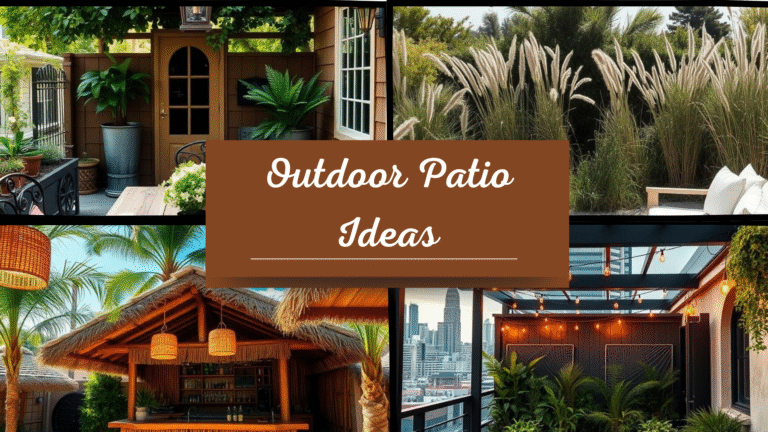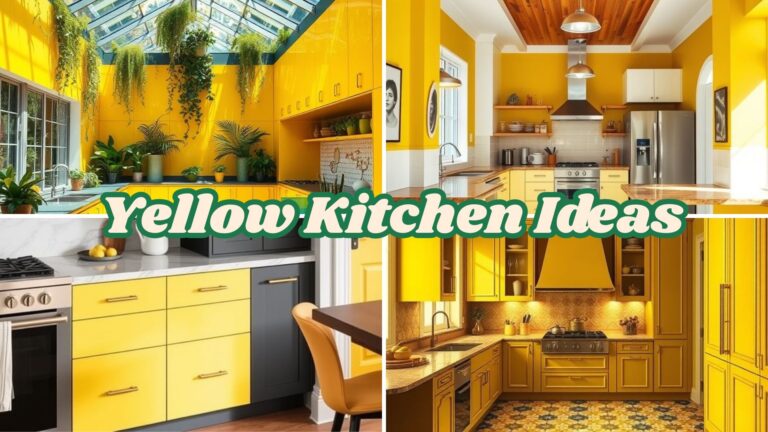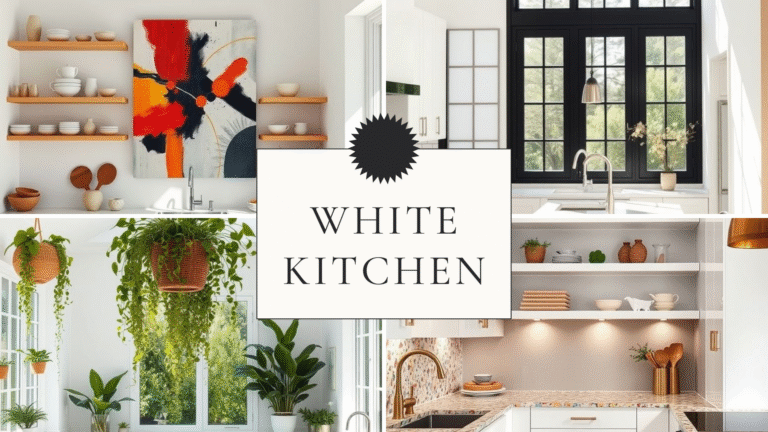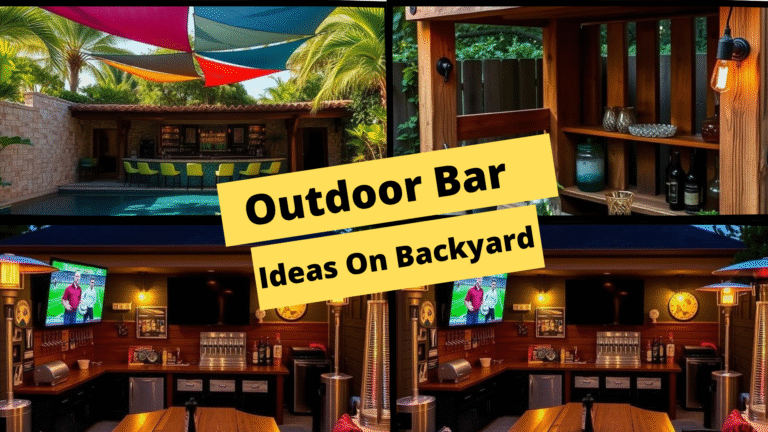20 Landscape Yard Ideas: From Moon Gates to Green Walls
Great outdoor spaces don’t happen by accident—they’re the result of clear purpose, durable materials, and a planting plan that fits your climate. Whether you’re dreaming of a Zen rill, a family-friendly veggie zone, or a tropical hideaway, the best yards balance beauty with low-effort upkeep. Think in layers: structure (paths, walls, pergolas), living elements (trees, shrubs, perennials), water and light, and finally the comforts that make you linger.
This guide turns twenty concepts into actionable designs you can adapt to any lot size. Each section breaks down layout, materials, plants, lighting, and maintenance so your yard looks good on day one and better every season. Start with site basics—sun, wind, soil, drainage—then choose the idea that fits your lifestyle and budget.
Asian-inspired Yard With Moon Gate and Pond
Begin with strong symbolism and simple geometry. A circular moon gate becomes your threshold—framing views and slowing the pace as you step through. Align the gate with a focal point (stone lantern, specimen maple) so every arrival feels intentional.
Keep the planting palette restrained. Japanese maple, bamboo clumps (in root barriers), evergreen azalea, and groundcovers like mondo grass create year-round structure. Use three foliage textures—fine, medium, broad—for quiet contrast instead of many flower colors.
Anchor serenity with water. A small koi pond or still reflecting basin set just inside the gate doubles the drama and cools the microclimate. Add a discrete skimmer, biofilter, and a slow-moving spout to keep water clear and oxygenated.
Edit hardscape materials. Choose split-face granite or basalt for stepping stones, gravel (3–6 mm) for crunch paths, and charred shou sugi ban fencing for a dark, calm backdrop. Keep joints tight and patterns simple to emphasize negative space.
Light with intention, not brightness. Low, shielded path lights, one underwater puck in the basin, and a soft uplight on the maple are enough. Warm color temps (2700K–3000K) protect the meditative mood.
Plan maintenance as ritual. Skim leaves weekly, thin bamboo annually, and clean the filter on a schedule. A small rake for gravel and a bamboo broom for stone turn care into a peaceful habit rather than a chore.
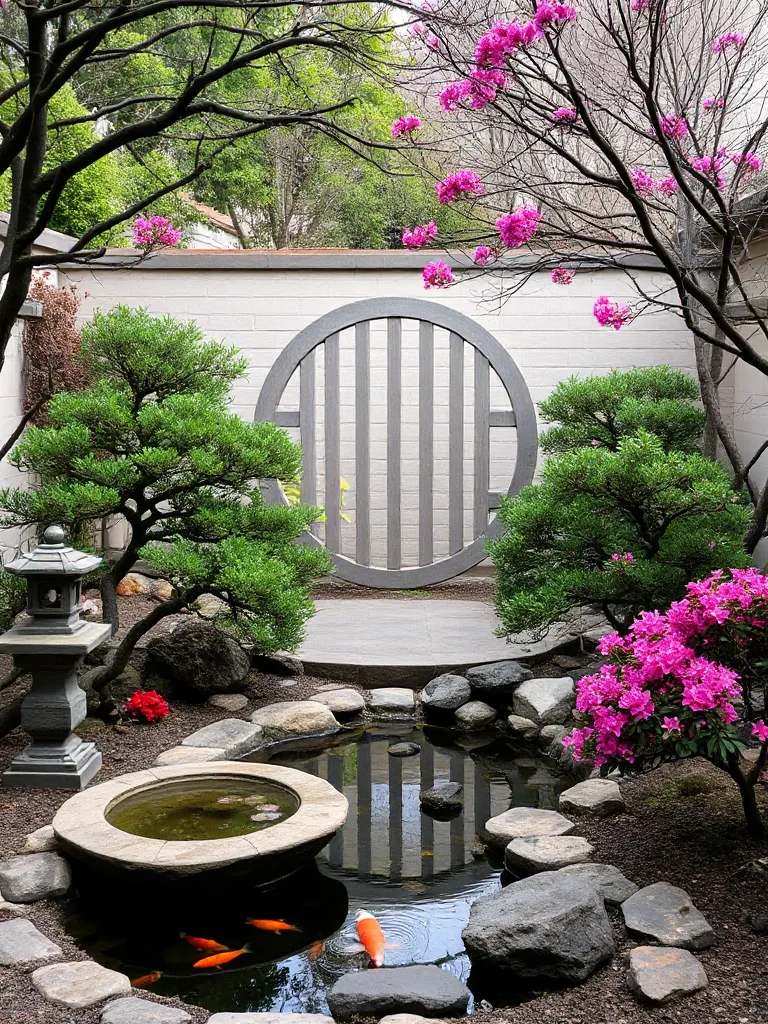
Backyard Entertaining Space With Outdoor Kitchen
Map zones first: prep/cook, serve, dine, and lounge. Keep the cook zone downwind of seating and within 3–4 m of the indoor kitchen for easy restocking. A U- or L-shaped counter creates a safe triangle between grill, sink, and fridge.
Specify outdoors-only materials. Use stainless or marine-grade powder coat for cabinetry, porcelain or granite for counters, and a vented, insulated grill jacket near any combustible surfaces. Add task lighting under the counter lip and a dimmable pendant over the island.
Design for flow. A 1.2 m clear aisle around the kitchen prevents bottlenecks; a pass-through ledge or window to the house turns plating into a team sport. Include a landing zone beside the grill and a heat-resistant trivet built into the counter.
Comfort is king. Shade the dining area with a pergola, sail, or louvered roof; add a ceiling fan or portable misters for hot days and a strip heater for shoulder seasons. Opt for performance fabrics and quick-dry cushions on lounge seating.
Plan utilities smartly. Run a dedicated gas line, GFCI-protected outlets, and a cold-water line with backflow prevention. A pull-out trash, paper-towel nook, and drawer for grill tools keep surfaces clear.
Make cleanup painless. A hand-spray at the sink, sealed pavers underfoot, and a soft-closure cover for the grill extend longevity. Store a grill brush, eco degreaser, and microfiber kit in a weatherproof drawer so shutdown is a five-minute routine.
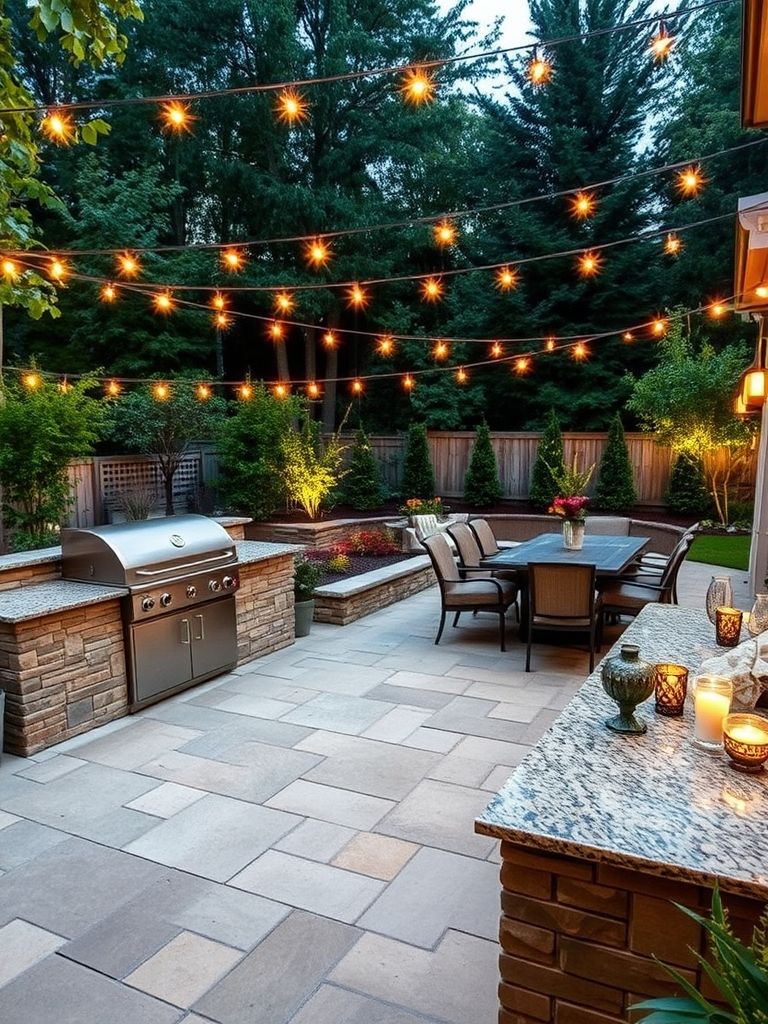
Backyard Pathway Illumination With LED Steps
Start with safety, then style. Any change in elevation—steps, landings, terracing—deserves dedicated lighting. Integrate low-glare LED step lights into risers or tuck linear strips beneath nosings for even illumination.
Choose the right optics. Louvered or shielded fixtures push light down and away from eyes; frosted lenses prevent dotting. Aim for 1–3 foot-candles on treads—bright enough to see, dim enough to preserve night ambiance.
Coordinate color temperature. Keep all path and step lights warm (2700K–3000K) to flatter planting and stone. If you use cooler light for water features, isolate it so temperatures don’t clash in the same view.
Wire for reliability. Use low-voltage (12V) with a transformer, waterproof connectors, and accessible junction points for future changes. Where wiring is tricky, battery or solar step lights can supplement—but test for winter performance.
Layer guidance, not floodlight. Add a few bollards at curves, tiny uplights to graze a low wall, and a moonlight-style downlight in a tree to create depth. Avoid overlighting; your eyes need shadows to read texture.
Maintain like a pro. Brush dirt from lenses, trim plants back from fixtures, and check connections at the start of each season. Keep spare lamps and a driver on hand so a single failure doesn’t darken a whole run.
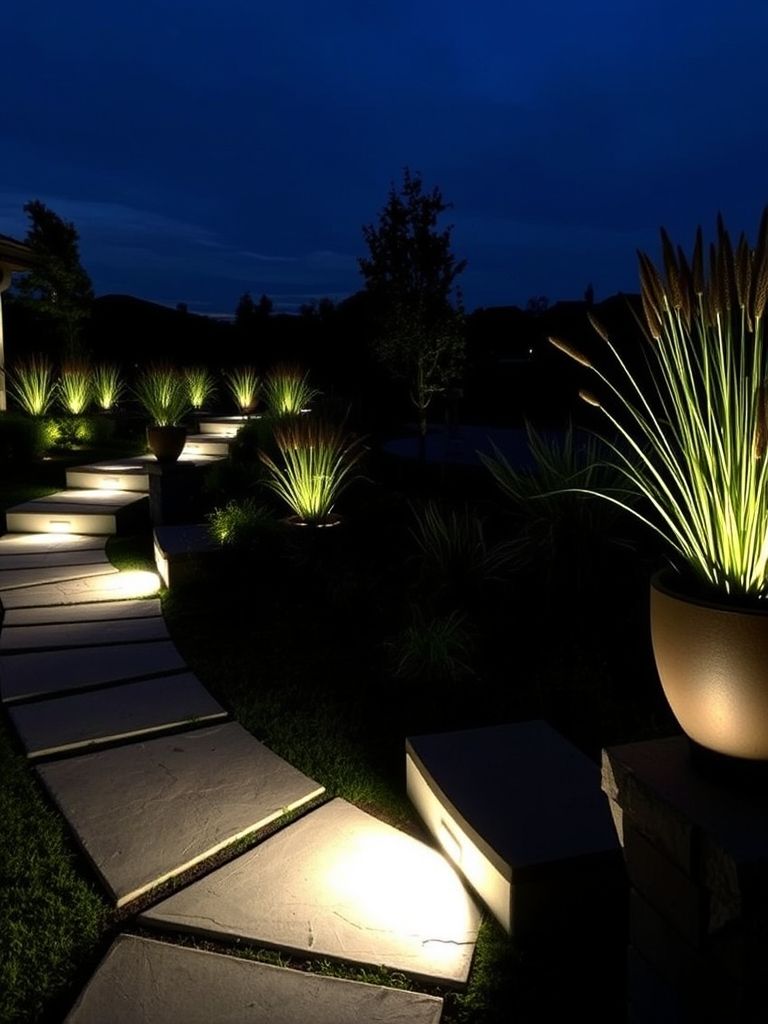
Backyard Retreat With Hammock and Pergola
Think micro-resort: shade, sway, and seclusion. Site the pergola to catch breezes and filter sun; add a retractable canopy or climbing vines for midday protection. Position the hammock just outside the main traffic line so movement feels private.
Pick the right hammock for the job. A spreader-bar style feels open and is easy to enter; a classic gathered-end cradles more snugly. If trees aren’t available, install rated posts or a freestanding stand and verify load capacity.
Layer ground comfort. A pea-gravel or decomposed-granite pad with stone edging drains well and crunches pleasantly underfoot. Add a low platform deck or outdoor rug beneath a side table for a “no-sand-in-the-drink” landing zone.
Make the rhythm effortless. A side caddy hooks on the pergola post for a book and water bottle; a small fan or mister makes nap weather perfect. discretely route power to a post base for phone charging and a dimmable lantern.
Soften the frame with planting. Fragrant climbers (star jasmine, honeysuckle) and a couple of ornamental grasses move with the breeze and amplify the sense of rest. Keep thorny or messy plants away from hammock edges.
Night mode matters. Fairy lights woven through beams, a low fire bowl at safe distance, and one path light to the house make late reading or stargazing easy. Covers on the hammock and cushions keep dew at bay until morning.

Coastal Landscape With Driftwood and Dune Grass
Honor the shoreline palette: sand, slate, sea-glass, and sun-bleached wood. Use weathered boardwalk planks or shell paths to lead from house to lounge and keep feet out of hot sand or gravel.
Let grasses do the poetry. Mix native dune species—Ammophila, Panicum, Festuca—for movement and erosion control. Plant in loose drifts, not dots, and keep the color story silvery-green with seasonal tawny tones.
Curate driftwood and stone as sculpture. One major trunk half-buried like a relic, a stack of flat stones for a seat, and a rope-wrapped post give narrative without clutter. Resist the urge to scatter many small pieces.
Choose resilient, salt-tolerant companions. Beach rose, sea holly, lavender, and low junipers shrug off spray and wind. Keep irrigation minimal; coastal plantings look best a little wild.
Keep furniture low and light. Sling chairs, teak benches with open slats, and canvas shade sails feel nautical and resist gusts. Anchor umbrellas with vented canopies and serious bases.
At night, mirror moonlight. Low, shielded path lights, lanterns behind driftwood, and a single downlight on a sculptural grass create a soft glow. Avoid blue LEDs; warm light keeps the coastal calm.
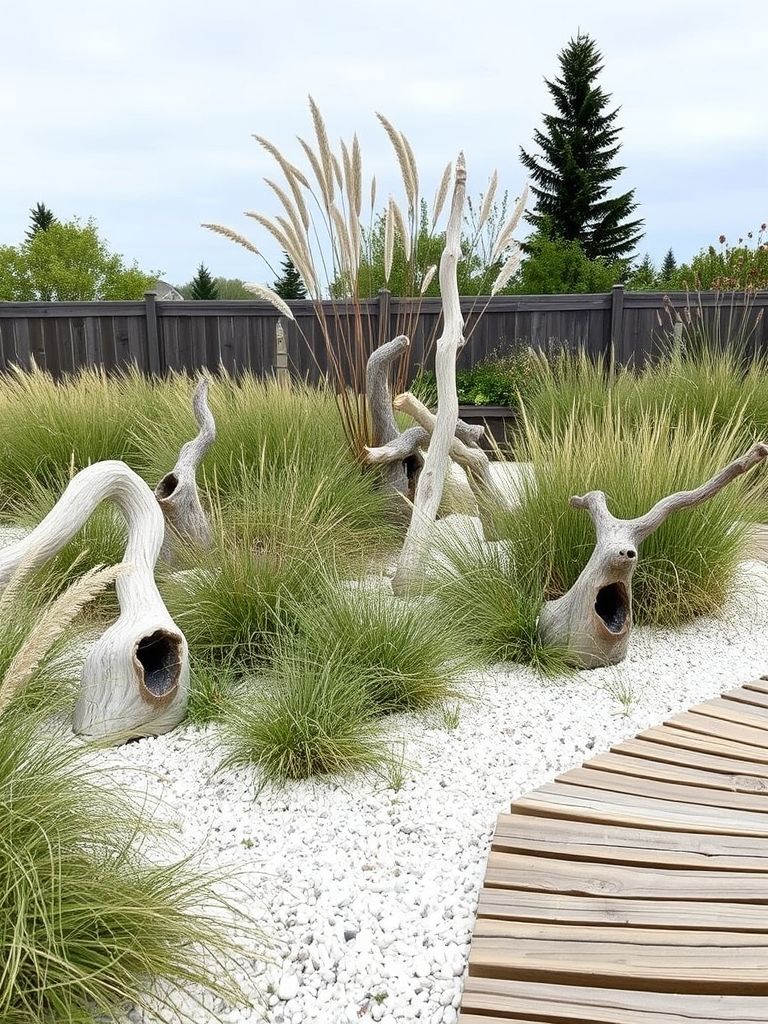
Colorful Pollinator Garden With Curved Paths
Design for bloom succession. Aim for nectar from early spring to frost: bulbs and wild columbine in spring, bee balm and coneflower in summer, asters and goldenrod in fall. Curved paths invite slow wandering and enlarge small spaces visually.
Group in generous clumps. Mass 5–9 of a kind so pollinators can forage efficiently and color reads from a distance. Repeat key colors along the path for rhythm—magenta, gold, and violet are reliable crowd-pleasers.
Layer structure for winter interest. Ornamental grasses, seed heads, and a few evergreen shrubs keep the garden alive when flowers fade. Leave seed heads standing for birds and winter texture.
Provide water and rest stops. A shallow bubbler or saucer with pebbles gives butterflies and bees safe sipping spots. Flat sunning stones help insects warm up on cool mornings.
Skip pesticides; choose soil health. Compost, leaf mulch, and right-plant-right-place reduce pest pressure naturally. If you must intervene, use spot-on organic controls in the evening when pollinators are least active.
Keep paths practical. Decomposed granite or wood chips feel soft underfoot and drain well; steel edging holds clean curves. Tuck a bench at a bend so you can sit and watch the garden work.
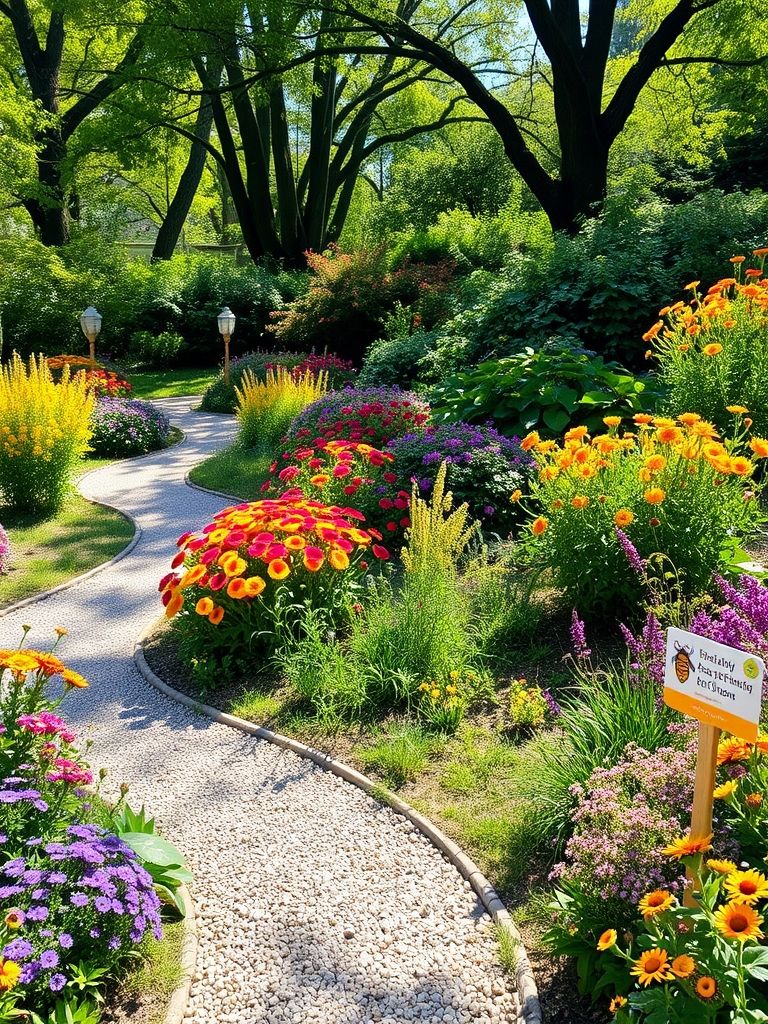
Contemporary Courtyard With Fire Pit
Center the layout on a simple geometric hearth—rectangular or circular—so seating naturally radiates around it. Keep circulation clear with a 1.2 m walking loop, and place the pit where prevailing winds won’t blow smoke into doors or neighbors.
Choose non-combustible finishes: porcelain pavers, concrete, or decomposed granite underfoot, and a steel or concrete fire feature with a certified burner. Tempered glass wind guards help in breezy courtyards without blocking heat.
Furnish low and streamlined. Boxy sectionals, armless lounge chairs, and a couple of ceramic drum tables keep sightlines open and feel modern. Performance fabrics in charcoal, bone, and taupe ensure the palette stays calm.
Layer light for evening drama. In-floor step markers, wall-wash sconces, and a single tree uplight create depth without glare. Keep all LEDs warm (2700–3000K) so the flame remains the star.
Add living structure in restrained bands. Grasses, clipped evergreens, and one sculptural specimen (olive, Japanese maple) read graphic against smooth hardscape. Use gravel or steel edging for razor-clean lines. Design for easy shutdown. A deck box holds covers and a long lighter; a shutoff valve sits within reach; and a hose bib nearby simplifies ash-zone rinses. Annual burner service keeps performance safe and steady.
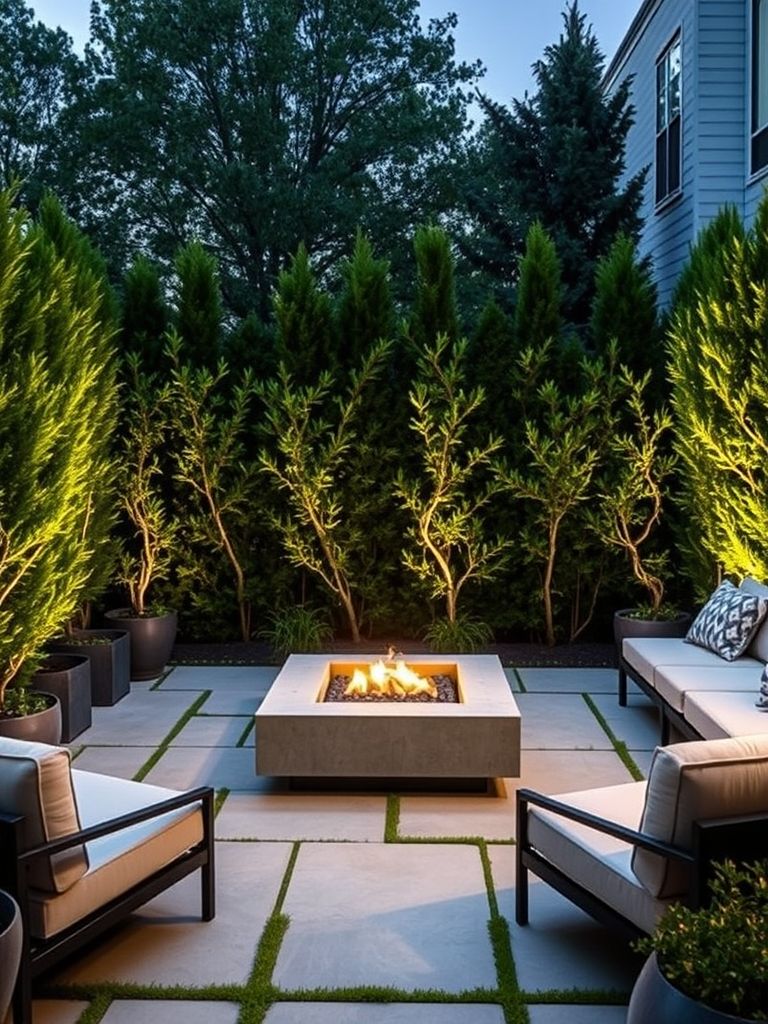
Desert-Inspired Drought-Tolerant Yard
Work with planes of texture instead of lawn. Crisp ribbons of gravel, decomposed granite, and flagstone establish paths and patios while reducing water use dramatically. Build a plant palette that loves neglect. Agave, yucca, cacti, desert spoon, and salvias deliver sculptural forms and seasonal color. Repeat plants in clusters for rhythm and to simplify irrigation zones.
Create microdrama with elevation. Low berms and sunken pockets cast long shadows and catch precious rain; boulders half-buried look natural and slow runoff. Keep grading subtle for a refined look. Shade is comfort. A slatted pergola, tension sails, or palo verde for dappled cover make summer usable. Choose light-colored hardscape to reduce heat gain underfoot.
Irrigate smartly. Deep, infrequent drip lines grow resilient roots; gravel mulch slows evaporation and keeps the scene tidy. Group plants by water needs to avoid overwatering tough species. Night reveals a second garden. Tiny uplights graze agave spines, and downlights from pergola beams mimic desert moonlight. Resist overlighting—shadows are part of the magic.
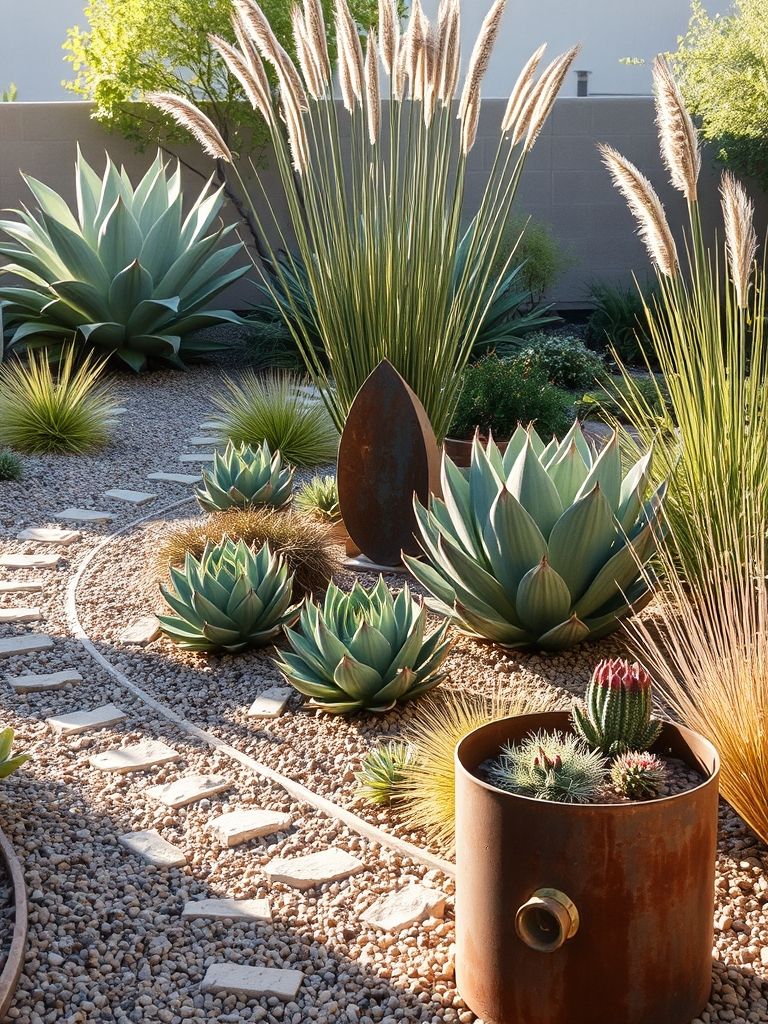
Enchanted Woodland Yard With Natural Trail
Let the path meander. A soft, curving trail of wood chips or compacted fines invites slow walking and protects tree roots better than solid paving. Plant for layers and habitat. Under tall canopy trees, add mid-story dogwood or serviceberry, then ferns, hostas, and woodland phlox on the floor. Mossy patches and log piles welcome beneficial insects.
Work with found materials. Fallen branches become edging, and a few well-placed boulders offer perches along the trail. A simple wood footbridge over a swale adds story and keeps feet dry. Keep water gentle. A small seep, birdbath, or recirculating bubbler adds sound and life without feeling formal. Use smooth stones and leaf litter to keep everything natural.
Light like fireflies. Low, shielded path markers and tiny pinlights tucked under logs give a whisper of guidance without breaking the spell. Warm, dimmable LEDs are essential. Maintenance should feel like tending, not battling. Leaf mulch stays, invasive vines go, and pruning focuses on safety and dappled light. The goal is curated wildness.
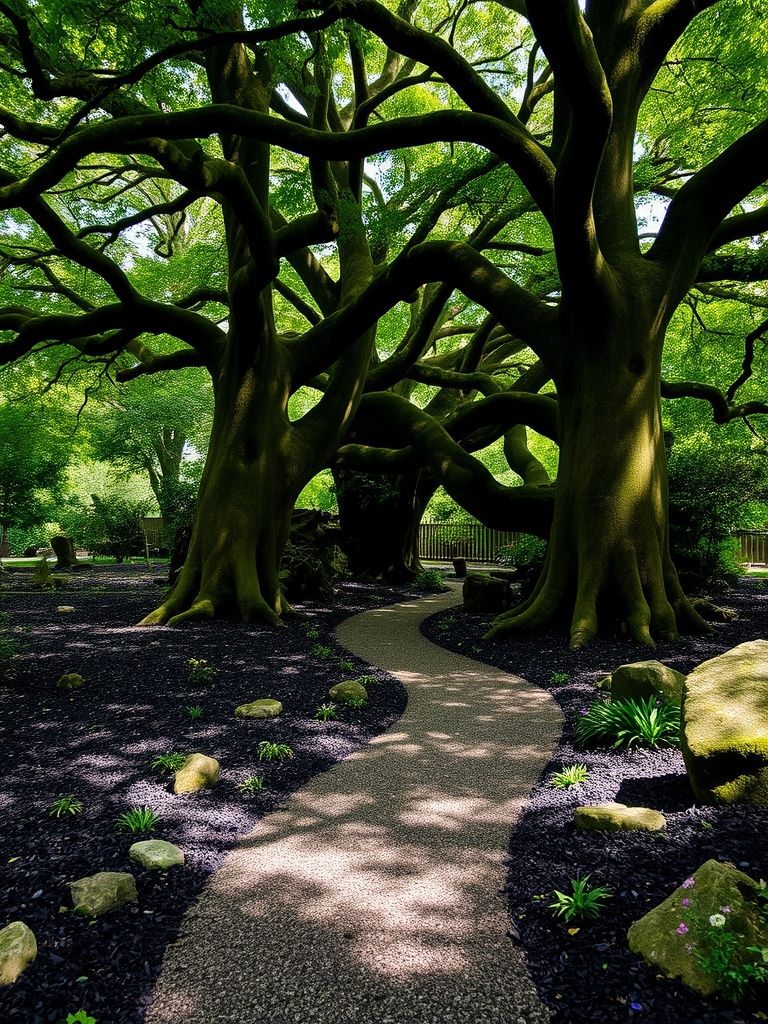
European Courtyard Garden With Gravel Paths
Define the room with walls—stucco, brick, or clipped hedges—so the courtyard feels enclosed and intimate. A centered fountain or urn becomes the quiet focal point. Lay compacted gravel (6–10 mm) with a solid base and steel edging for crisp paths that drain well. Add stone pavers at doors and dining areas for stable footing under chairs.
Choose an elegant, restrained palette. Boxwood, lavender, rosemary, and espaliered fruit trees deliver form, scent, and seasonal interest without clutter. Terracotta pots unify the scene. Furnish for lingering. A metal bistro set for morning coffee, plus a stone-topped console for candles and carafes, turns the courtyard into daily ritual space. Linen-look outdoor cushions keep it soft.
Lighting should glow, not glare. Wall lanterns, a couple of uplights on espalier, and candles in hurricane sleeves set the evening mood. Keep fixtures traditional but simple. Mind upkeep. Rake gravel smooth, clip hedges clean, and refresh limewash or stucco where sun bites. Drip lines on pots make summer care effortless.

Family-Friendly Yard With Raised Garden Beds
Zone for play, plant, and pause. Keep raised beds within sight of a patio so supervising is easy, and carve a soft-surface play strip along the lawn edge for cartwheels and chalk. Build beds to ergonomic heights—45–60 cm for kids, 75–90 cm for adults—and at widths under 1.2 m so everyone can reach the middle. Use rot-resistant wood or metal troughs with lined interiors.
Design simple irrigation. A timer-controlled drip system with quick-connects means watering won’t be forgotten. Mulch generously to keep soil cool and hands clean. Make learning natural. Label herbs, add a bug hotel, and tuck a bench between beds for story time. A nearby hose reel and potting caddy keep tools tidy and accessible.
Choose resilient paths. Decomposed granite or rubber tiles keep knees safe and drains well after water fights. Low edging contains mulch and defines routes. Plan seasonal turnover. Cool-season greens give way to summer tomatoes, then fall carrots and bulbs. A compost bay closes the loop and turns chores into science.
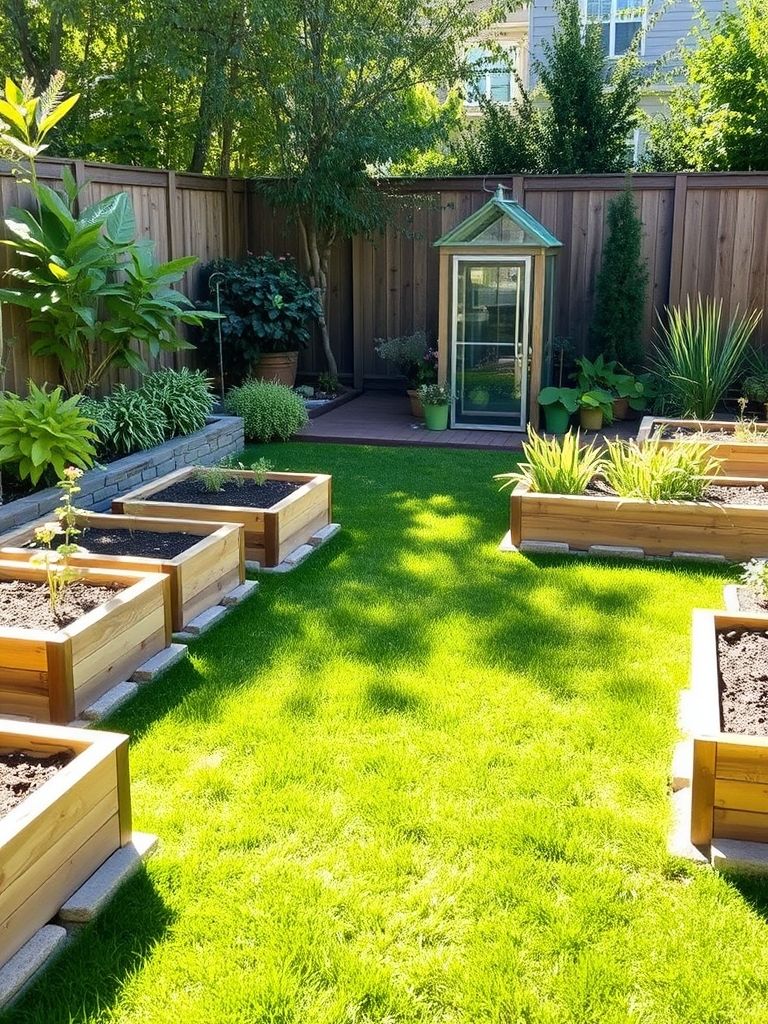
Mediterranean Yard With Olive Trees and Terracotta
Lead with sun-washed materials—terracotta pots, limewash walls, and travertine-look porcelain. The palette should feel warm, chalky, and timeless. Use olive trees as living architecture. Multi-stem specimens in ground or large pots frame dining areas and cast dappled shade. Underplant with thyme, santolina, and lavender for silver-green harmony.
Carve space with low walls and benches. A simple masonry seat wall doubles as extra seating and defines patios without fencing. Mosaic-topped tables add artisanal sparkle. Invite long meals. A generous farm table under a reed mat pergola, string lights, and a small outdoor kitchen with a pizza oven turn evenings into rituals.
Keep water features simple. A wall spout into a stone basin cools the air and masks street noise without feeling fussy. Choose patinated brass or aged iron for taps. Low-maintenance is the brief. Drip irrigation, gravel mulch, and tough, drought-friendly plants mean your yard looks as good in August as in May.

Minimalist Gravel Yard With Modern Sculptures
Edit to essentials. Replace lawn with a field of pale gravel punctuated by two or three strong elements: a corten planter, a black stone plinth, and one striking sculpture. Compose with negative space. Group elements asymmetrically and leave generous breathing room so each form reads clearly. Use steel or aluminum edging to keep lines immaculate.
Add a single living layer. A row of clipped evergreens or a grid of ornamental grasses introduces life without busyness. Repeat species for calm. Choose a limited material story—gravel, corten, black stone, and evergreen. Variations in texture and scale carry the design where color does not.
Light sparingly. Grazing uplights on sculpture bases and one wall wash are enough. Avoid visible fixtures; the pieces should appear to glow. Maintenance is raking and the occasional prune. A wide-tooth rake patterns gravel into zen-like waves and resets footprints in minutes.
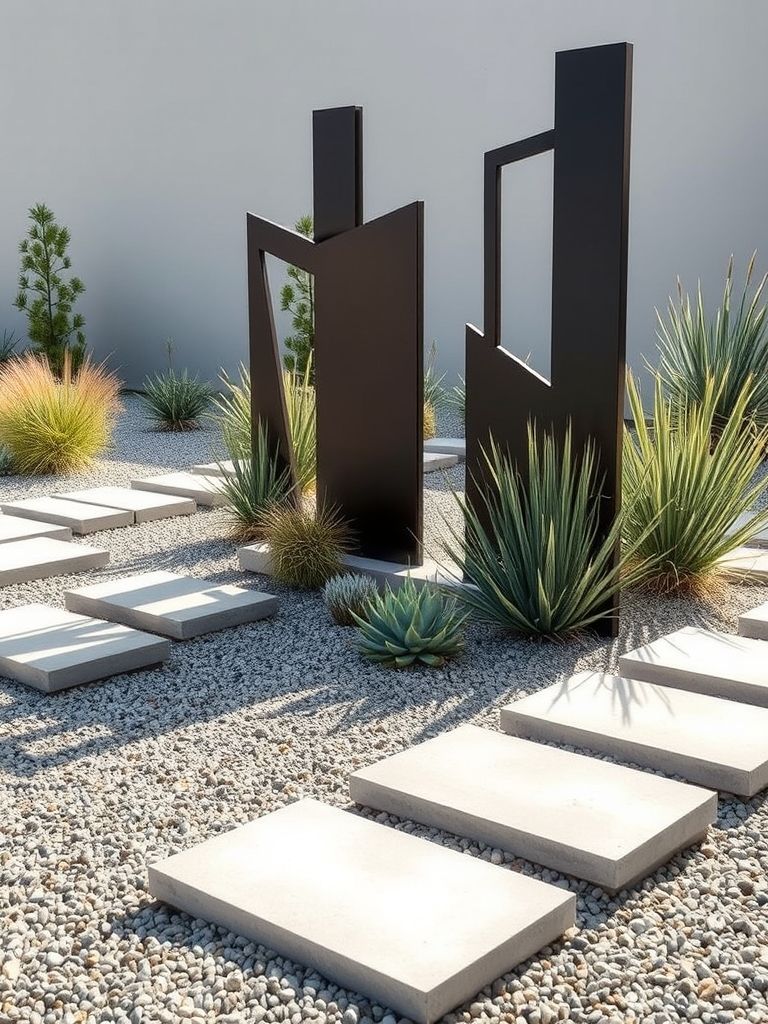
Modern Zen Yard With Water Rill
Let water guide the plan. A narrow, shallow rill runs from a raised source to a calm basin, creating movement and sound without splash. Keep edges crisp with honed stone or concrete. Strip the palette. Smooth plaster or charred wood walls, pale stone pavers, and a single species hedge provide quiet structure. The rill becomes the event.
Plant sparingly but with intent. One sculptural pine, a clump of bamboo (in barriers), and a carpet of moss or mondo grass deliver texture at three scales. Bridge the rill with a simple slab or timber stepping stone. The moment of crossing slows pace and heightens awareness—classic Zen choreography.
Hide mechanics well. A skimmer and pump basin beneath a removable grate keep water clear and maintenance easy. A GFCI outlet and discreet access panel are non-negotiable. Light like moonlight. A single submersible puck at the source and soft wall washers along the run are plenty. Reflections should shimmer, not sparkle.
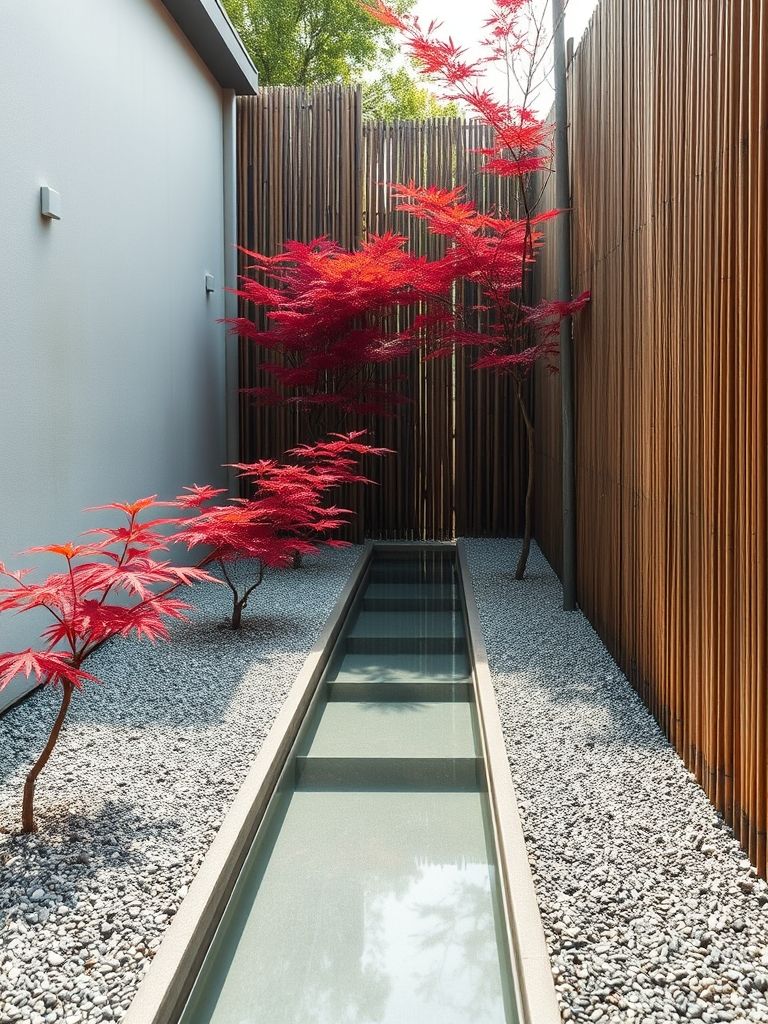
Rain Garden With Native Plants and Stones
Turn runoff into beauty. Site the garden in a low spot, sized to capture roof and patio water, and dig a shallow basin with overflow to a safe drain point. Layer the basin with structure. River stones at inlets slow flow; a sandy loam mix drains quickly; and a ring of larger boulders defines the edge and offers perches.
Plant natives that tolerate wet-to-dry swings. Think sedges, iris, joe-pye weed, coneflower, and swamp milkweed for pollinators and seasonal bloom. Place thirstier plants deeper in the basin, tougher ones on the rim. Lead water visibly. A shallow swale or chain from a downspout makes the system legible and delightful during storms. Kids love watching the garden “work.”
Keep maintenance seasonal. Clear inlets, cut back stems in late winter (leaving some for habitat), and top up mulch annually. Avoid fertilizers—they defeat the filtration purpose. Add a small interpretive sign if visible from the street. Neighbors learn, and you get fewer “why is this wet?” questions when the rains come.
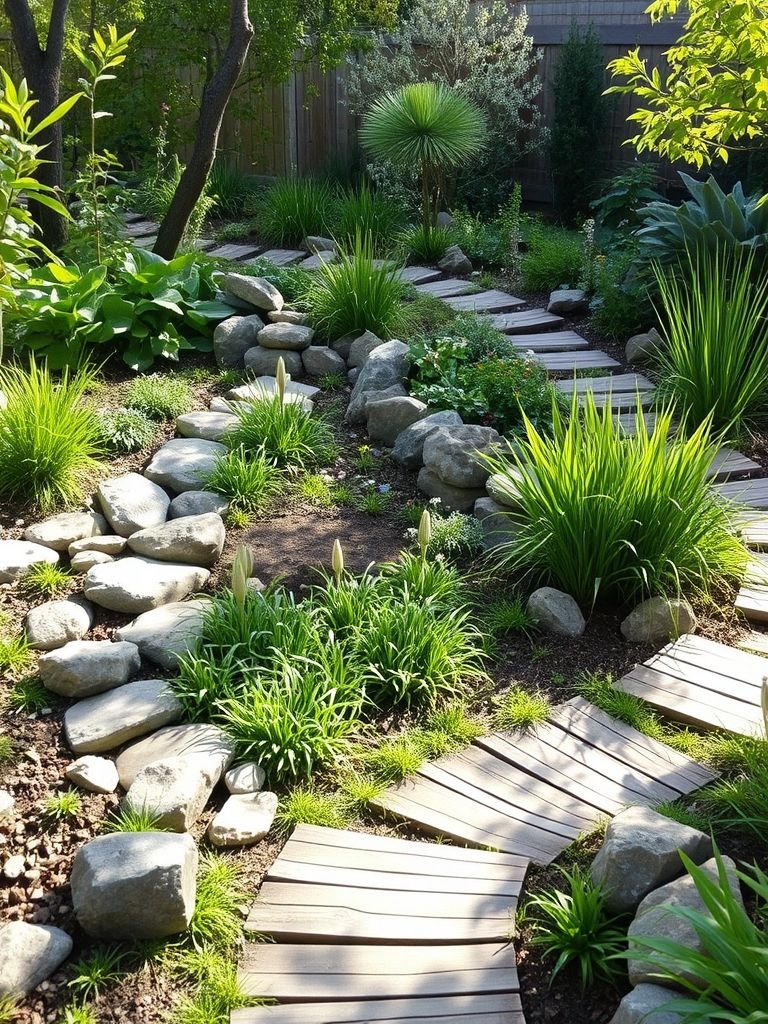
Rustic Farmhouse Yard With Split Rail Fence
Frame the property with a classic split rail—weathered wood that sets a friendly boundary without feeling shut-in. Let meadowy grasses and wildflowers weave through the rails. Anchor the scene with honest materials. Crushed stone paths, a timber arbor, and galvanized troughs as planters or stock-tank ponds bring working-farm charm.
Furnish sturdy and simple. Adirondack chairs around a low fire ring, a picnic table under a shade tree, and a potting bench by the shed invite everyday use. Grow a kitchen garden nearby. Raised beds edged in cedar, berry canes along a fence line, and an herb wheel by the door make farm-to-table effortless.
Light with lanterns and string bulbs. Keep fixtures utilitarian—barn sconces by doors and a motion light at the drive. Warm color temps flatter wood and stone. Maintenance celebrates patina. Oil hinges, tighten rails, and mow paths through the meadow. The goal is tidy edges with a relaxed core.
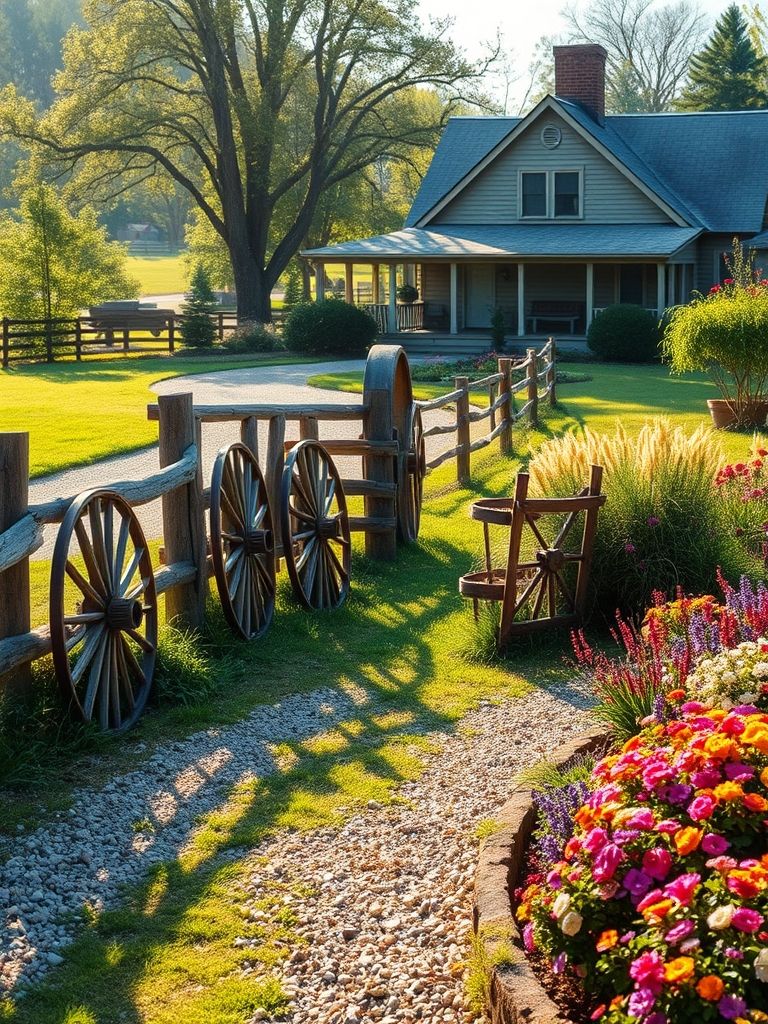
Symmetrical Formal Garden With Hedge Design
Start with an axis. A centered path from door to focal point—urn, statue, or water—organizes everything. Cross paths create quadrants for planting or gravel panels. Clip structure sharply. Boxwood, yew, or privet hedges define beds and outline geometry. Keep heights consistent and corners square for crisp legibility.
Plant infill with restraint. Seasonal color in repeat blocks—tulips, salvias, alliums—keeps form primary and bloom secondary. A limited palette reads elegant, not busy. Hardscape should echo symmetry. Identical benches, paired urns, and mirrored gates strengthen the rhythm. Use limestone or brick laid in traditional patterns.
Irrigation and drainage are hidden heroes. Even moisture keeps hedges dense; discreet channel drains prevent puddling along straight runs. Pruning is the ritual. Two or three clips a season, a string line, and sharp shears preserve the garden’s architecture better than any ornament.
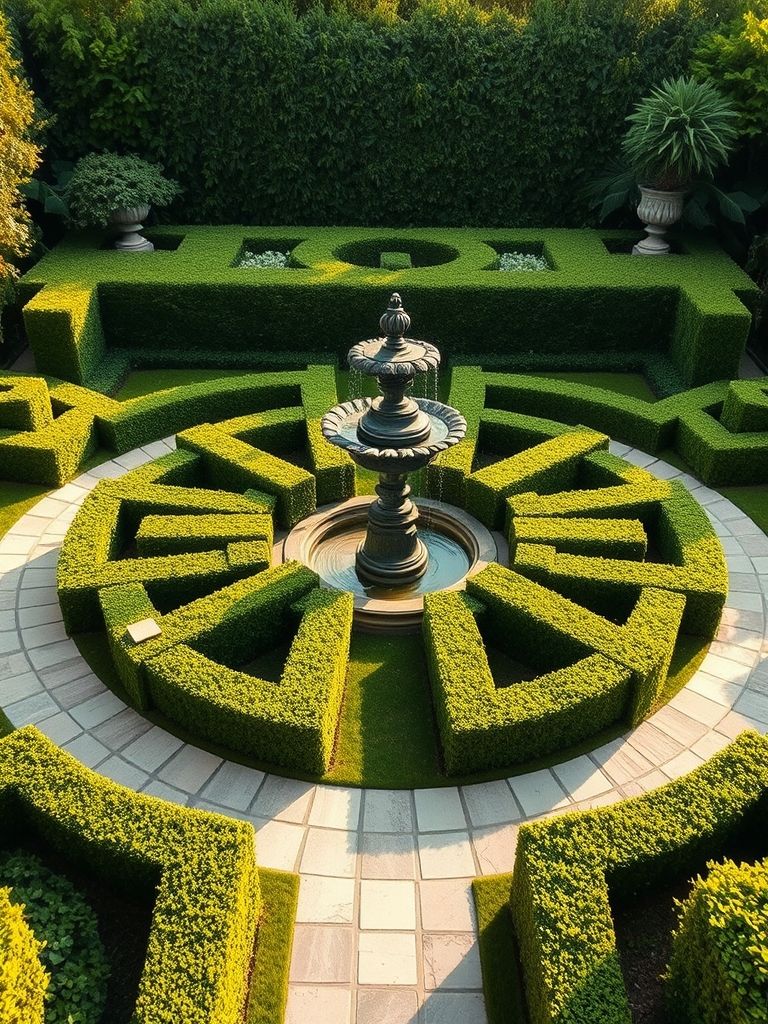
Terraced Hillside Yard With Retaining Walls
Tame slope into outdoor rooms. Step the grade into usable terraces—play, dine, and grow—connected by comfortable stairs with landings. Engineer first, then beautify. Use properly drained, reinforced retaining walls—structural concrete, segmental block, or engineered timber—designed for your soil and load.
Blend walls into the landscape. Stone veneers, planted pockets, and cascading groundcovers soften structure. A narrow bench atop a wall doubles as seating with a view. Design stairs you’ll love to use. 15–17 cm risers with 30–33 cm treads feel natural; add low step lights and a handrail that matches wall materials for safety.
Manage water meticulously. Perforated drains behind walls, weep holes, and permeable surfaces on terraces keep hydrostatic pressure at bay. Plant by microclimate. Upper terraces are drier and windier; lower ones cooler and richer. Choose accordingly for thriving, low-maintenance beds.

Tropical Backyard With Lush Layers
Create a green envelope. Tall palms and bamboo form the canopy; philodendron, heliconia, and ginger fill the understory; ferns and mosses complete the floor. Curate meandering paths. Stepping stones through groundcover and a small timber bridge over a rill turn the yard into a resort walk. Keep lines soft and organic.
Design shade and airflow together. A thatch-look or louvered pavilion plus a damp-rated ceiling fan keeps humidity comfortable and fabrics dry faster. Lean into saturated color. Lagoon, coral, and turmeric accents on cushions and ceramics pop against deep greens, while big surfaces stay neutral.
Water is the soundtrack. A recirculating wall spout or hidden basin fountain adds hush and masks city noise. Keep pumps accessible for easy cleaning. Plan for pests and maintenance. Discreet nets, citronella planters, and regular pruning of broad leaves keep the jungle lush, not overgrown. Quick-dry textiles are non-negotiable.
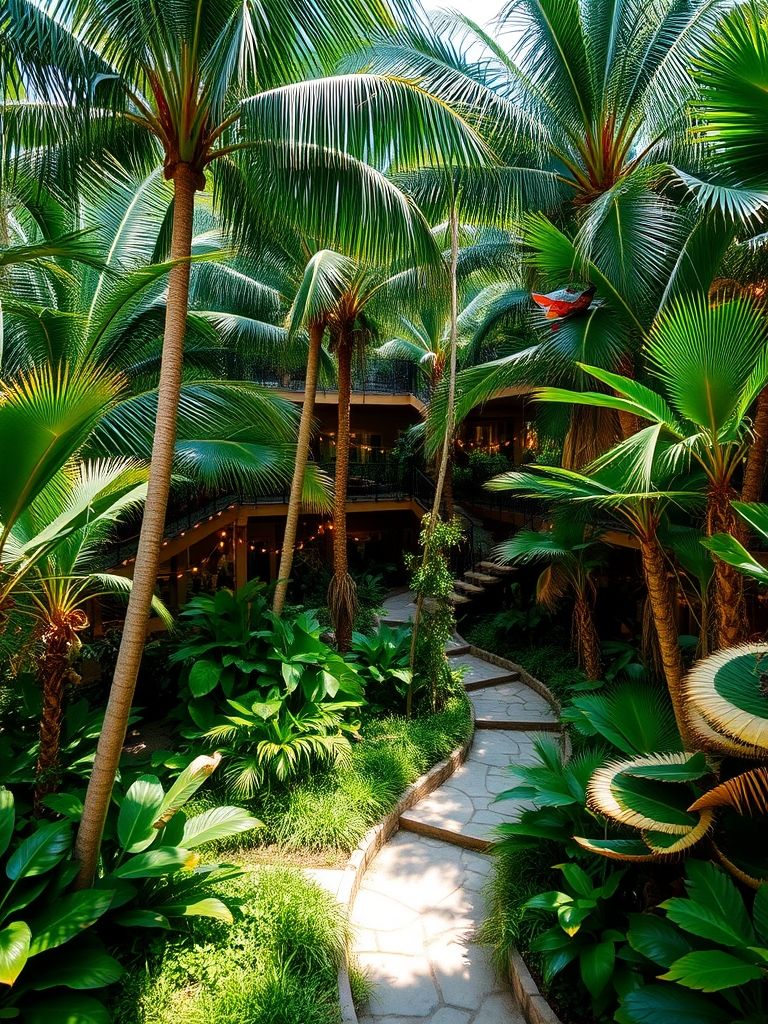
Urban Oasis With Privacy Green Wall
Build your boundary up, not out. A modular trellis or living-wall system screens neighbors and swallows noise while keeping the footprint compact. Select plants by light and depth. Sun: star jasmine, trumpet vine, or trained bougainvillea. Shade: ivy, creeping fig, or clivia pockets. Mix evergreens for year-round coverage with bloomers for seasonal hit.
Pair green wall with calm hardscape. Large-format pavers, a simple bench, and one sculptural planter keep focus on the living tapestry. A compact water bowl cools the microclimate. Integrate irrigation and maintenance. A drip manifold and access panel mean quick checks; leaf catch trays protect paving. Schedule quarterly trims to keep thickness controlled.
Layer cozy cues. Warm string lights along the top rail, a couple of lanterns, and a cushioned loveseat make the space invitation-ready after dark. Keep color temps warm. Hide the city’s mess. A slatted screen conceals bins and AC units; a storage bench swallows cushions and tools. The oasis feels effortless because the work lives out of sight.
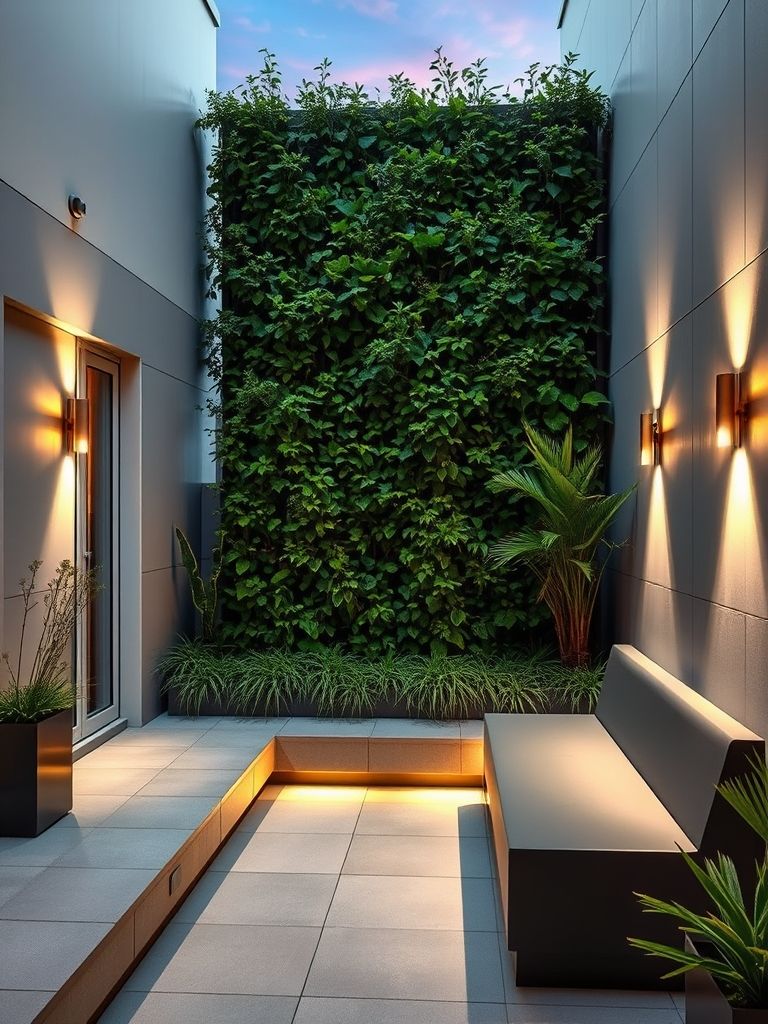
Conclusion
Treat your yard like a sequence of experiences—threshold, path, pause, and view—and every square meter starts to work harder. Choose materials that suit your climate, plants that thrive on the water you actually have, and lighting that flatters rather than floods. Build in maintenance shortcuts—drip irrigation, storage, durable finishes—so the space looks good on regular days, not just reveal day. When function and feeling align, your landscape becomes a place you live in, not just look at.

